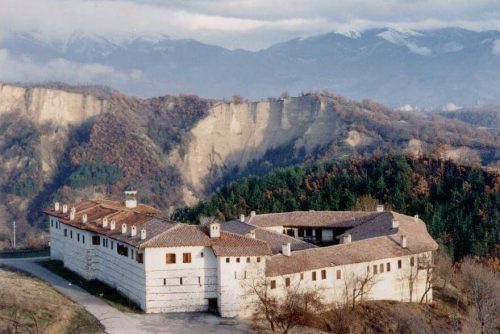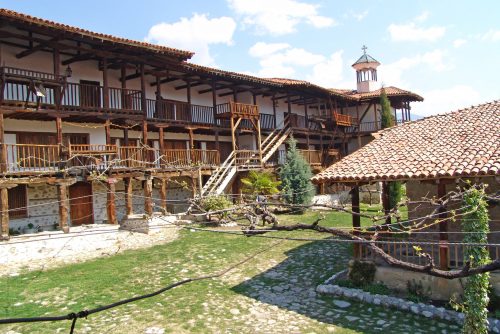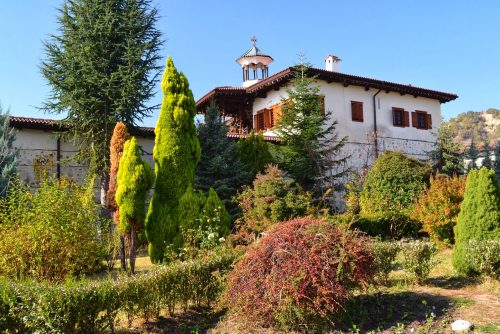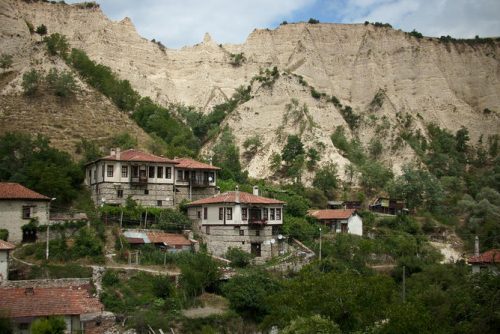Rozhen Monastery: Beautiful Nature and Centuries of History
You can visit one of the oldest medieval monasteries in Bulgaria, only a few kilometers away from the town of Melnik and near the famous Melnik Pyramids.
The Rozhen monastery of the “Nativity of the Mother of God” is among the most precious jewels in Pirin Mountain. Its unique architecture, rich history, and collection of valuable icons attract hundreds of visitors from the country and abroad.
So, the next time you’re near Melnik, Bansko, or the Southwestern region of Bulgaria, make sure you follow the guide below and experience the unique spirit of the Rozhen monastery!
History of the Rozhen Monastery
With over ten centuries of history, the Rozhen monastery has seen the rise and fall of empires. Many of its authentic testimonials are still surviving in the present days, while some are also restored and renovated.
Which is the earliest written source about the biggest monastery near the town of Melnik, and what happened with it throughout the ages? Our brief historical tour starts in the paragraphs below.
When Was The Rozhen Monastery Found?
The history of the holy cloister in the Pirin mountains began long ago, raising several disputes about the exact time of its establishment. According to one of the researchers, there was a monastery in this place even in the 12th century, while others’ opinion is that the monastery was established a century later.
We are not specialists and do not have our own hypothesis, so we accept the official one. According to it, the monastery complex was founded at the beginning of the 13th century.
Historians date the earliest archaeological evidence of medieval life in this area to the end of the 13th century, with a grave and a few coins giving evidence for that.
Experts also support their hypothesis with a correspondence found, which is a part of a Greek manuscript that says there was a monastery above the town of Melnik. Nevertheless, the earliest written source testifying officially to the monastery’s existence is a chant book in Mount Athos that dates back to 1551.
From the historical document, it becomes clear that the Rozhen Monastery existed during the rule of the despot Alexey Slav (governor of Southwestern Bulgaria in the 13th century), and it was a significant cultural, economic, and literary center.
That was the time when, behind the walls of the monastery and in its new buildings, educational science was carried out, books were written, and theological issues were discussed.
Rozhen Monastery During Ottoman Rule
With the invasion of the Ottoman Empire in the Bulgarian lands, and especially the conquest of the Melnik region at the end of the 14th century, the fate of the monastery complex drastically changed. Or else said – the place sank into oblivion.
For almost a century, there was no information about what happened with the sacred cloister, and its fate remained unknown until 1551.
Then, priest Kozma – the current-time abbot of the monastery cloister – mentioned its existence in one of his manuscripts. In the manuscript, priest Kozma said the present name of the monastery complex for the first time – “Virgin Mary Rosinotisa” (Rozhenska).
So, little by little, the monastery came out of oblivion, and the gaps in its history started to fill. It is clear that at the beginning of the Turkish invasion, it sustained severe ruination, and in the 16th century, it was restored.
At that time (16th century), one of the residential buildings, the dining room, and the big church were restored and rebuilt. Approximately during the same period, the dining room of the monastery and the church were decorated with mural paintings and frescoes.
The Ups and Downs of the 17th and 18th Century
The restoration and the rise of the monastery dramatically stopped again during the 17th century. Then, for unknown reasons, a fire broke out, which destroyed the library and a large part of the residential buildings of the abbey.
From the documents found, today we know that the largest fire was after the rule of the metropolitan of Melnik Sylvester, who was а prelate from 1661 to 1667.
Despite the hardships and the plight in which the Rozhen monastery fell after the fire, it was restored again in the 18th century. Back then, wealthy Bulgarians from the whole country were raising money and helping in the restoration of both the main building and the auxiliary facilities.
In the middle of the 18th century, the sacred cloister was fully restored and financially stabilized. The restoration works, which were undertaken precisely during that period, attested to that. Then, in 1715, the primary reconstruction of the Rozhen monastery buildings started, and in 1732, the main church was repainted with frescos.
Unfortunately, despite the apparent rise, the monastery had to endure more challenging periods.
The Autonomy Challenges of the Rozhen Monastery
Ever since the time of its founding, the Rozhen Monastery was declared stavropegial. That means the cloister was autonomous and subordinate only to the Ecumenical Patriarch.
That was one of the main reasons why the Turks did not raze it on the grounds. But also, the fact that it was subordinate to the Ecumenical Patriarch had most likely become why, later in the 18th century, its autonomy was withdrawn by the Greek Church in 1761.
As a reason for the withdrawal of autonomy, the Greek Church pointed out the financial difficulties. And more precisely, the Rozhen Monastery’s dependence on the Iveron Monastery in Mount Athos.
Monks of the Iveron Monastery took over the management of the sacred cloister, so the monastery turned into a cloister of the Iveron Mount Athos (Svetogorski) Monastery.
Until 1912, the monastery was a cloister and a part of the Iveron Monastery. Then it became a Bulgarian one. That was not liked by the Greek clergy and was followed by years of courts which ended in 1921 in favor of Bulgaria.
The Monastery’s Architecture
The monastery complex has an irregular hexagonal shape and consists of residential and farm parts, a main church, and an ossuary.
The residential parts form something like improvised protection to the main church, which is located in the center of the monastery complex.
The Main Church
The church temple was built in the 16th century, but for several reasons mentioned above, it was reconstructed in the 18th century.
There are no specific details about what the church looked like initially, but in its present appearance, it represents the three-apsed, three-nave, domeless building.
In itself, the church is a unique architectural jewel, but what raises the visitors’ curiosity is its internal design and the murals in particular with which it was painted.
The Murals and Stained Glass
The earliest frescoes and murals in the monastery are from the 16th century. They decorate the narthex of the church and tell mainly about the miracles that Christ created after his Resurrection. The scenes are painted in detail and are very emotionally impactful for the visitors.
In the naos of the church, the paintings follow the stylistics of the Balkan paintings of the 18th century. However, unlike the frescoes in the narthex, here, the works are much more diverse.
For example, in addition to the compositions, there are the mandatory-for-every-Christian-temple images of the Virgin Mary; also, on the upper parts of the northern and southern walls are painted 24 stanzas of the Virgin Mary’s Akathist.
The Iconostasis
The Iconostasis in the church dates back to the same time as the murals and is the second most impressive artifact in the temple. It was created during the church reconstruction in 1732 and was made with exceptional finesse and craftsmanship.
The threaded interlaced work, which covers all its embossed parts, the perfectly drawn bouquets of flowers on the plinth parts, and the gilt, carved elements, create such a serene harmony that everyone who looks at it remains silent for a long time.
The Miraculous Icon
One of the most valuable icons in the Rozhen Monastery is the miraculous icon of “The Holy Virgin Portaitissa“. The icon is one of the copies of the miraculous Virgin Mary icon, which was found in the sea by monks from Mount Athos.
“Holy Virgin Portaitissa” was painted in 1790 by a monk from the Iveron monastery and was ordered together with a special ark.
We will never be able to say whether the icon is really miraculous. But, there is no way we can deny the fact that every year, on the patron’s day of the monastery (8th of September), laymen from all over the country come to the Rozhen Monastery to ask the “Holy Virgin Portaitissa” to bring them curing.
The Monastery Dining Room
Another site in the sacred cloister that attracts attention is the monastery dining room. Perhaps now, you will say that there is nothing so fascinating in a dining room compared to a miraculous icon… But you will not be at all right.
The dining room in the Rozhen Monastery is one of the most interesting buildings in the monastery complex. The dining room is inbuilt in one of the monastery’s residential wings, but this is not the most intriguing thing about it. Instead, it’s the fact that during the restoration works, specialists discovered that the room was built on thick medieval walls.
The monastery dining room is a rectangular room with an apse, which was painted with fresco compositions of “The Last Supper.”
The Residential Buildings
The residential buildings for the monks in the monastery complex were rebuilt during two periods – in the 16th and 18th centuries.
The older one of the two monastic wings is a two-storeyed building with verandahs, which surrounds the main church on the east, west, and south sides.
This part of the monastery was built in the 16th century, along with the monastic cells in it, the refectory, and the cellars in which the monks kept their food stocks. The monastery dining room is located in this wing as well.
The second monastic wing is a three-storeyed one, and it was built in the 18th century with money donated by the Melnik craftsmen. This wing was designed for the reception of the monastery guests, and on the first floor was the cattle shed.
The Ossuary
There is an ossuary to the monastery complex, which is also worth seeing. The ossuary was built in 1597, representing a church temple with а tomb and a place for worship.
Once you walk through the central gate of the monastery, all of its parts will be yours to explore.
Whether you believe in the Christian God or not, a walk around the site will give you a one-of-a-kind experience that blends religion, nature, culture, and history.
How to Get to the Rozhen Monastery?
The monastery complex is situated 6 km away from the town of Melnik and about one kilometer from the village of Rozhen. If you get to Melnik, there is no way you can lose your way, as it is the only one, and it will take you directly to the monastery gates.
In addition, there is a vast meadow in front of the monastery, where you can have a great picnic if you wish and you have time.
If you have not planned a picnic in your program, eating in the town of Melnik is a good idea since the Rozhen monastery does not offer food and accommodation.
Other Sites You Can Visit Near the Rozhen Monastery Complex
Besides a few other medieval Bulgarian monasteries, the Rozhen monastery is also circled by village tourism destinations, mountain cities, and incredible natural landmarks.
The Town of Melnik
Melnik is a popular tourist destination for food and wine tourism that has a few medieval Bulgarian monasteries nearby, including the Rozhen monastery. The smallest town in the country is one of the 100 national sites, and it is unthinkable to go to the Rozhen Monastery and not take the time to view the town.
In addition to the delicious food and the famous wine (which we recommend you to try), Melnik will impress you with its National Revival architecture, quiet cobblestone streets, and numerous museums.
The Melnik Pyramids
There is no way you can skip the Melnik pyramids. They rise up to 100 meters in height and are found northeast of Melnik in the Rozhen Monastery direction. The rock formations were declared a landmark in 1960 and were listed under number 4 in the list of the 100 national sites.
You can also enjoy the pyramids from afar while traveling to the monastery or view them from nearby if you take the eco-trail. It starts from the town of Melnik, then passes by the Melnik pyramids, and reaches right in front of the gates of the Rozhen Monastery.
The eco-trail is well-marked; it is also suitable for children, and the time needed to pass it is about one hour and a half. This eco-trail also makes a perfect day trip from most mountain towns in the region.
Because Rozhen monastery is just a pearl in the larger crown of the Pirin mountain, and you can dive as deep into the experience as you wish to!



